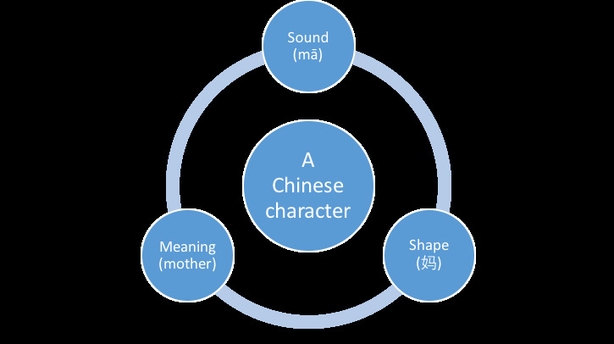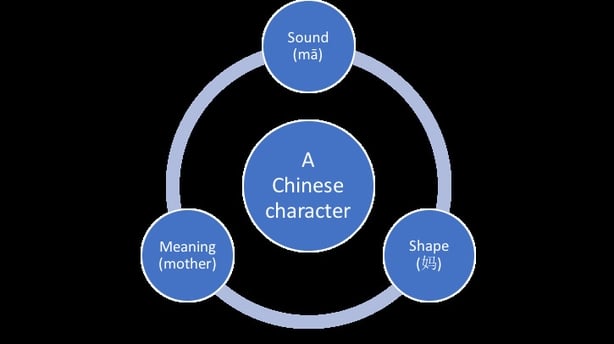Analysis: learning Chinese means studying the sound, shape and meaning of each character
Brainstorm readers may remember that Caitríona Osborne recently pointed out the unique features of the Chinese writing system which have led it to be considered difficult to learn. One aspect of Chinese that is different from English is the relatively unsystematic and unreliable association between the sound and the shape of a word or a Chinese character.

As shown above, it is unlikely that someone could guess that the written form of "mā" is 妈 (meaning mother), based only on its pronunciation. In other words, learners of Chinese need to study all three integral parts of each Chinese character: the sound, shape and meaning.
Furthermore, handwriting in Chinese requires attention to character composition and the pairing of the writing movement with the language stimulus – the Chinese character. This pairing can contribute to long-lasting motor memories of Chinese characters and therefore offer additional assistance for character recognition. For this reason, the write-to-read effect makes handwriting necessary in the study of Chinese.
But the usefulness of handwriting in the digital era has been questioned in recent years, since typewriting using keyboards is more attuned to contemporary lifestyle. In China, children are usually taught to type on a computer and touchscreen during the third year of primary school. Even some Chinese language proficiency tests are computer-based nowadays, requiring learners of Chinese to use input software to type Chinese. For example, the widely known HSK test (mainland China’s national standardised test of Chinese language proficiency, which is also available to learners of Chinese in Ireland) offers a computer-based mode which allows the typing of Chinese to answer questions.
There are generally two types of Chinese input: pinyin input and component input. The former entails typing Chinese pinyin – a Romanised form representing the sound of each Chinese character – and then choosing the intended option from a list of homophones. The picture below shows how to type "mother" using the Google pinyin input method. We type the pinyin "ma" and then select the correct character. In this case, it ’s number four on the list generated by the software. Component input entails drawing the basic structure of a character and then selecting the correct option from a list of characters with a similar structure provided by the input system.

One similarity between these two input methods is that neither encourages memorising whole character representations, especially when a fuzzy matching technique is embedded in the input system. That is to say, even if pinyin is not fully or correctly written, the pinyin input system is still able to find the most similar pronunciation. Likewise, for the component input method, a list of computer-generated possibilities can be shown to users for selection even if a character is not structured properly.
On the one hand, typewriting, which does not require memorising every single detail of a character, can help reduce the anxiety and frustration associated with learning Chinese characters. It also equips learners of Chinese with the ability to communicate in the digital world. On the other hand, concerns have been raised regarding the potential negative impact of typewriting on Chinese learning in the long term, due to reliance on auto-correction and software-generated possibilities. A study conducted by the author shows that adult learners of Chinese are usually aware of the pros and cons of handwriting and typewriting, and demonstrate their desire to maximise the benefits of each writing modality for their study of Chinese.
Indeed, with the frequent use of electronic devices for communication nowadays, it is no longer a question of whether typewriting should be included in a language learning curriculum. Rather, the central questions are when and how to teach typewriting to language learners. Research carried out by the author has found that it would be beneficial to introduce typewriting at pre-intermediate level in the specific context of learning Chinese as a foreign language, when learners already have a solid language foundation. Instead of spending time on micro-level details, learners are then able to allocate more of their attention to relatively high-order thinking, such as choosing appropriate vocabulary, structuring sentences properly, and planning the best way to present ideas in a logical order.
After introducing Chinese as a two-year state-examined subject, the National Council for Curriculum and Assessment (NCCA) recently released a draft specification for Leaving Certificate Mandarin Chinese. There are a number of items that need to be discussed and clarified, such as the number of characters to be taught at this level, the actual content covered in the course and the medium of instruction.
Interestingly, the draft specification states that "students will be … familiar [with] digital scripts including the most commonly used fonts for Mandarin Chinese". It might be too early to introduce typewriting on the Leaving Certificate course, as the foundations of the writing system are not yet solid for students. But it is a good idea to at least allow learners of Chinese to be exposed to the digital scripts which may prepare them for future learning through typewriting.
手写或打字——汉语学习的未来是什么?
RTÉ Brainstorm的读者可能还记得Caitríona Osborne的文章(https://www.rte.ie/brainstorm/2018/1025/1006672-how-hard-is-it-to-learn-chinese/)指出了学习汉字的困难之处。汉语与英语不同的一个地方就是汉字的"形"与"音"之间相对不系统且不可靠的对应关联。

如上图所示,仅凭发音,人们很难猜出"mā"的书面形式是"妈"(意思是母亲)。换句话说,中文学习者需要学习每个汉字的所有三个组成部分,即形、音、义。
此外,手写汉字要求注意字符的组成,以及书写动作与语言刺激(汉字)的配对。这种配对有助于对汉字的长期记忆,从而能更好地识别汉字字符识。因此,手写对汉字识别的积极效应,使手写在汉语学习中成为必不可少的部分。
但是,近年来,由于使用键盘输入系统的打字显然更符合现代生活方式,因此在数字时代手写汉字的用途受到质疑。在中国,通常在小学三年级时就教孩子们在计算机和触摸屏上打字。如今,一些汉语语言能力测试都是基于计算机的,要求汉语学习者使用输入软件来键入汉字。例如,广为人知的HSK考试(中国大陆的汉语水平标准测试,对爱尔兰的汉语学习者开放)提供了基于计算机的考试模式,允许键入汉字来回答问题。
中文输入通常有两种类型:拼音输入法和部件输入法。前者需要输入汉语拼音(一种代表每个汉字声音的罗马化形式),然后从同音字列表中选择所需的汉字。下图显示了如何使用谷歌拼音输入法键入"妈"。我们输入拼音" ma",然后选择正确的字符。在下面这个例子中,正确的汉字是该软件生成的列表中第四个。

部件输入法需要绘制字符的基本结构,然后从输入系统提供的相似结构的字符列表中选择正确的选项。
这两种输入方法之间的相似之处在于,它们都不鼓励记忆整个字符,尤其是模糊匹配技术已嵌入到输入系统中。也就是说,即使拼音没有被完全或正确地书写,拼音输入系统仍然能够找到最相似的发音。同样,对于部件输入法,即使字符结构不正确,也可以向用户显示计算机生成的所有可能的汉字列表,供用户选择。
一方面,因为打字过程中学习者不需要记住字符的每个细节,所以可以减少汉字学习中的焦虑和沮丧。学习了打字,还能使中文学习者具有在当今数码世界中进行交流的能力。另一方面,由于依赖自动校正和软件生成的可能的汉字列表,从长远来看,打字对中文学习的潜在负面影响也引起了人们的关注。本文作者进行的一项研究(https://doi.org/10.1016/j.compcom.2019.102522)显示,成年中文学习者通常都知道手写和打字的利弊,并表明了他们希望最大程度地受益于这两种书写方式。
确实,随着当今电子设备的频繁使用,在语言学习课程中"是否"应包括打字已不再是一个问题。相反,中心问题是"何时"以及"如何"向语言学习者教授打字。本文作者进行的研究发现,在学习汉语作为外语的特定环境中,如果学习者已经具有扎实的汉语基础,那么在中级水平引入打字将是有益的。学习者无需花时间在汉字的微观细节上,而是可以将更多的注意力分配到相对高层次的思维上,例如选择适当的词汇,正确地构造句子,以及规划逻辑顺序以呈现观点的最佳方法。
在将汉语作为为期两年的爱尔兰高中科目之后,NCCA(国家课程与评估委员会)最近发布了《普通话高中毕业证书》规范草案(https://www.ncca.ie/en/updates-and-events/consultations/leaving-certificate-mandarin-chinese-consultation)。草案中确实有一些内容需要进一步讨论和澄清,例如,该级别要教授的汉字数量,课程实际涵盖的内容,以及教学语言,等等。直到2020年1月6日,NCCA都将接受公众对这个草案的反馈。
有趣的是,规范草案第26页指出"学生将……熟悉中文电子书写版本,包括中文最常用的字体"。在高中毕业证书中文课程中引入打字可能还为时过早,因为对于学生而言,书写系统的基础尚不牢固,但至少允许汉语学习者接触电子汉字确实是个好主意,对电子汉字的熟悉可以为将来学习打字做好准备。
The views expressed here are those of the author and do not represent or reflect the views of RTÉ



